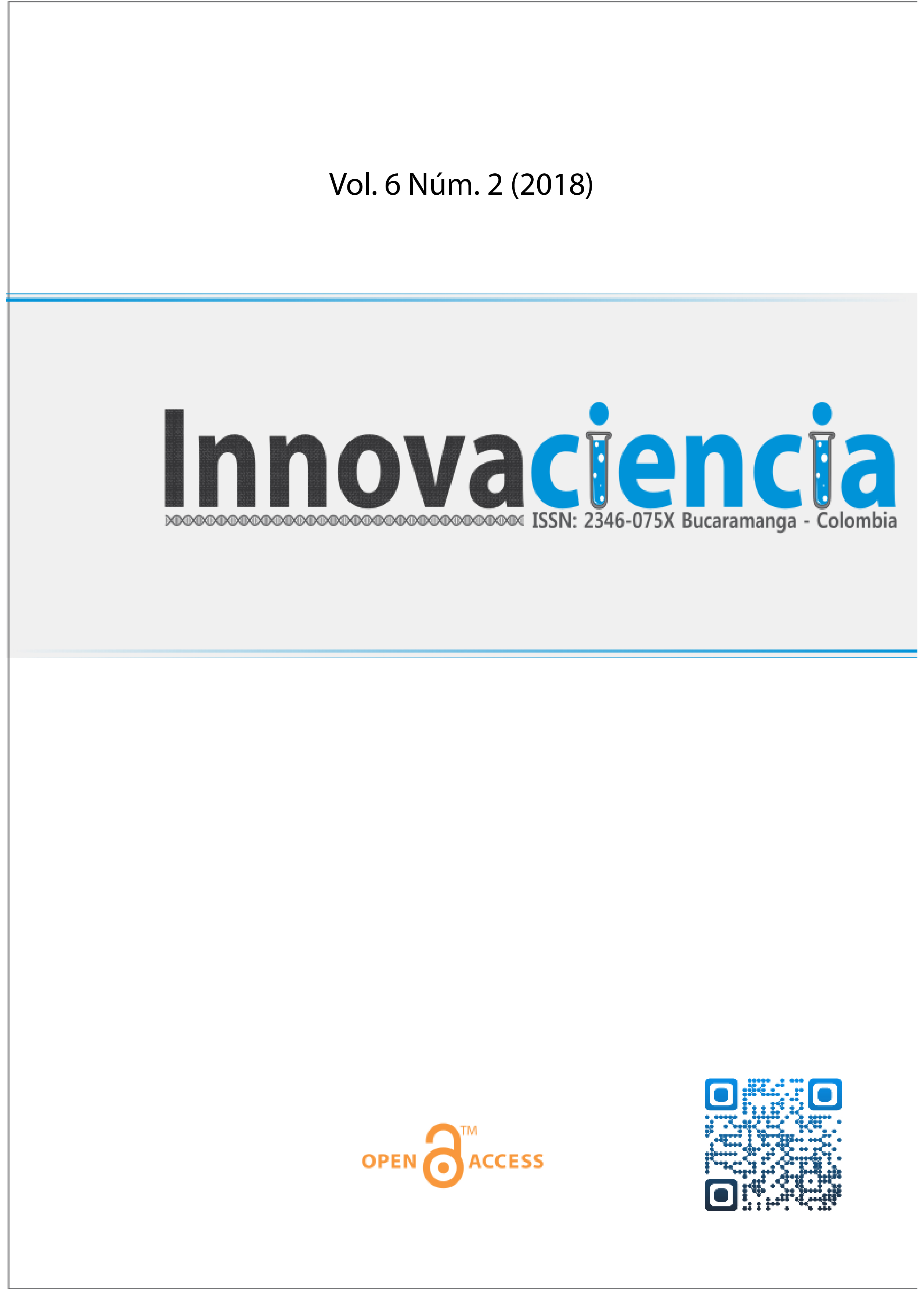Síntesis y evaluación antioxidante para monocarbonil curcuminoides y sus derivados
DOI:
https://doi.org/10.15649/2346075X.481Palabras clave:
Cucumine; Monocarbonylcurcuminoids; Antioxidant; DPPH; Pepronal; 4-thiomethoxy benzaldehydeResumen
Introduction: Curcumin is a yellow pigment extracted from the Curcuma longa L, which have a several biological activities and pharmacological properties. Curcuminoids have a wide range as antioxidant not only in a food system, but also for biological systems. Materials and Methods: Acetone, 4-thiomethoxy benzaldehy, pepronal, thiosemicarbazide, 4-phenylthiosemicarbazide and chloroethylacetate. The two Analogous of monocarbonyl curcuminoids (MCCs) have been synthesized by claisen –Schmidt condensation from the reaction between one mole of acetone with two moles of appropriate aromatic aldehydes (4-thiomethoxy benzaldehyde and pepronal) then synthesized their hetero derivatives. The pyrazols derived from the reaction MCCs with hydrazine or one of their derivative (thiosemicarbazide, 4-phenylhydrazine).Results and Discussion:All synthesized compounds were characterized by various spectroscopic techniques such as FTIR, 1HNMR, 13CNMR, Mass spectroscopies and CHN analysis. The antioxidant activity of synthesized MCCs, 1, 2, 1a, 2a, 3, were determined by the ability to scavenge the stable 1,1-diphenyl-2-picryl hydrazyl (DPPH) free radical according to Blois method. The DPPH inhibition activity was measured by spectrophometric method. The polyhydroxy curcuminoid has showed a high activity for scavenging of DPPH radicals, the reason is the hydroxyl phenolic group OH give the compound high activity of scavenging the radical by donating hydrogen atom to the DPPH radicals and inhibition the radical activity by hydrogen atom transfer (HAT). Therefore the scavenge of radical activitywill be in the order: 3>2a>1a>2>1 andthe half maximal inhibitory concentration (IC50) between (17.35-135.2) μmol/L.Conclusions: The proposed struc ture of the synthesized compounds were confirmed by used a spectroscopic technique such as, FTIR, Mass spectra (EI),1H and 13C NMR, The antioxidant activity of curcuminoids were studied by using DPPH as a source of radicals. The higher activity of compounds can be attributed to present the phenolic OH group.
Referencias
Baldwin PR, Reeves AZ, Powell KR, Napier RJ, Swimm AI, Sun A, et al. Monocarbonyl analogs of curcumin inhibit growth of antibiotic sensitive and resistant strains of Mycobacterium tuberculosis. European Journal of Medicinal Chemistry. 2015;92:693-9. https://doi.org/10.1016/j.ejmech.2015.01.020
Alsalim TAQ, Mzban HA, Abood EN. Synthesis and antioxidant study of new hydrazones derived from bisdemethoxycurcumin pyrazole. European Journal of Chemistry. 2017;8(4):344-8. https://doi.org/10.5155/eurjchem.8.4.344-348.1630
Zhu H, Xu T, Qiu C, Wu B, Zhang Y, Chen L, et al. Synthesis and optimization of novel allylated mono-carbonyl analogs of curcumin (MACs) act as potent anti-inflammatory agents against LPS-induced acute lung injury (ALI) in rats. European Journal of Medicinal Chemistry. 2016;121:181-93. https://doi.org/10.1016/j.ejmech.2016.05.041
Lozada-Garcia MC, Enriquez RG, Ramirez-Apan TO, Nieto-Camacho A, Palacios-Espinosa JF, Custodio-Galvan Z, et al. Synthesis of Curcuminoids and Evaluation of Their Cytotoxic and Antioxidant Properties. Molecules. 2017;22(4). https://doi.org/10.3390/molecules22040633
Gyuris M, Hackler Jr. L, Nagy LI, Alföldi R, Rédei E, Marton A, et al. Mannich Curcuminoids as Potent Anticancer Agents. Archiv der Pharmazie. 2017;350(7):e1700005. https://doi.org/10.1002/ardp.201700005
Martins CVB, da Silva DL, Neres ATM, Magalhães TFF, Watanabe GA, Modolo LV, et al. Curcumin as a promising antifungal of clinical interest. Journal of Antimicrobial Chemotherapy. 2008;63(2):337-9. https://doi.org/10.1093/jac/dkn488
NITA CHAINANI-WU DMD, M.P.H., M.S. Safety and Anti-Inflammatory Activity of Curcumin: A Component of Tumeric (Curcuma longa). THE JOURNAL OF ALTERNATIVE AND COMPLEMENTARY MEDICINE. 2003;9(1):8. https://doi.org/10.1089/107555303321223035
Kali A, Bhuvaneshwar D, Charles PMV, Seetha KS. Antibacterial synergy of curcumin with antibiotics against biofilm producing clinical bacterial isolates. Journal of basic and clinical pharmacy. 2016;7(3):93-6. https://doi.org/10.4103/0976-0105.183265
Mathew D, Hsu W-L. Antiviral potential of curcumin. Journal of Functional Foods. 2018;40:692-9. https://doi.org/10.1016/j.jff.2017.12.017
Sharma S, Gupta MK, Saxena AK, Bedi PMS. Triazole linked mono carbonyl curcumin-isatin bifunctional hybrids as novel anti tubulin agents: Design, synthesis, biological evaluation and molecular modeling studies. Bioorganic & Medicinal Chemistry. 2015;23(22):7165-80. https://doi.org/10.1016/j.bmc.2015.10.013
Liang B, Liu Z, Cao Y, Zhu C, Zuo Y, Huang L, et al. MC37, a new mono-carbonyl curcumin analog, induces G2/M cell cycle arrest and mitochondria-mediated apoptosis in human colorectal cancer cells. European Journal of Pharmacology. 2017;796:139-48. https://doi.org/10.1016/j.ejphar.2016.12.030
Blois M.S. Antioxidant determinations by the use of a stable free radical. Nature.1958; 181:1199-1200 https://doi.org/10.1038/1811199a0
Benmehdi H, Behilil A, Memmou F, Amrouche A. Free radical scavenging activity, kinetic behavior and phytochemical constituents of Aristolochia clematitis L. roots. Arabian Journal of Chemistry, 2017; 10: 1402-1408. https://doi.org/10.1016/j.arabjc.2013.04.015
Anand P, Thomas SG, Kunnumakkara AB, Sundaram C, Harikumar KB, Sung B, et al. Biological activities of curcumin and its analogues (Congeners) made by man and Mother Nature. Biochemical Pharmacology. 2008;76(11):1590-611. https://doi.org/10.1016/j.bcp.2008.08.008
Bayomi SM, El-Kashef HA, El-Ashmawy MB, Nasr MNA, El-Sherbeny MA, Badria FA, et al. Synthesis and biological evaluation of new curcumin derivatives as antioxidant and antitumor agents. Medicinal Chemistry Research. 2012;22(3):1147-62. https://doi.org/10.1007/s00044-012-0116-9
Ausra Voskiene aVM, a and Gema Mikulskiene. Synthesis and structural characterization of products condensation 4-carboxy-1-(4-styrylcarbonylphenyl)-2-pyrrolidinones with hydrazines. ARKIVOC 2007;(xv):303-14. https://doi.org/10.3998/ark.5550190.0008.f29
Emam DR, Alhajoj AM, Elattar KM, Kheder NA, Fadda AA. Synthesis and Evaluation of Curcuminoid Analogues as Antioxidant and Antibacterial Agents. Molecules. 2017;22(6).https://doi.org/10.3390/molecules22060971
Bade TS, Ebrahimi HP, Alsalim TA, Titinchi SJJ, Abbo HS, Bolandnazar Z, et al. A novel series of 1, 4-Dihydropyridine (DHP) derivatives bearing thiazolidin-4-one: From synthesis to structure. Journal of Molecular Structure. 2017;1138:136-48. https://doi.org/10.1016/j.molstruc.2017.03.005
Descargas
Publicado
Cómo citar
Descargas
Número
Sección
Licencia
Todos los artículos publicados en esta revista científica están protegidos por los derechos de autor. Los autores retienen los derechos de autor y conceden a la revista el derecho de primera publicación con el trabajo simultáneamente licenciado bajo una Licencia Creative Commons Atribución-NoComercial 4.0 Internacional (CC BY-NC 4.0) que permite compartir el trabajo con reconocimiento de autoría y sin fines comerciales.
Los lectores pueden copiar y distribuir el material de este número de la revista para fines no comerciales en cualquier medio, siempre que se cite el trabajo original y se den crédito a los autores y a la revista.
Cualquier uso comercial del material de esta revista está estrictamente prohibido sin el permiso por escrito del titular de los derechos de autor.
Para obtener más información sobre los derechos de autor de la revista y las políticas de acceso abierto, por favor visite nuestro sitio web.
















